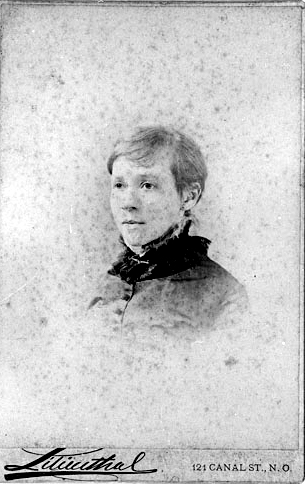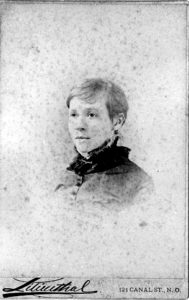Eliza Jane Nicholson
Eliza Jane Nicholson was the first woman publisher of a major daily newspaper in the United States. She was also a published poet, writing under the pen name Pearl Rivers.

The Historic New Orleans Collection
Black and white reproduction of a head and shoulders portrait of Eliza Jane Nicholson.
In 1876, Eliza Jane Nicholson became the first woman publisher of a daily metropolitan newspaper in the nation. She revolutionized the New Orleans Picayune, creating a lively, dynamic paper with feature stories, book reviews, a women’s page, an expanded Sunday edition, columns devoted to special topics (health, household hints, society), special Carnival editions with lithographs of parade floats, cartoons, and generous photographic illustrations. Nicholson herself wrote editorials, essays, dramatic monologues, and poetry under the pseudonym “Pearl Rivers.”
Born to an affluent lumbering family near Pearlington, Mississippi, on March 11, 1843, Eliza Jane Poitevent was reared on a large property in the pine woods along the Hobolochitto, a tributary of the Pearl River. She was educated at home and at the Amite Female Seminary in Liberty, Mississippi. After the Civil War, she began to publish nature-themed poetry in southern newspapers.
When she moved to New Orleans to become the first professional woman journalist in the South, her family was horrified and the men in the newsroom were hostile. In 1870, she became the literary editor of the Picayune; at that time, she dropped six years from her age in official biographies. In 1872, she married the Picayune’s owner, Colonel Alva Holbrook. At his death in 1876, she inherited an almost bankrupt newspaper that she was determined to rescue.
During Eliza Nicholson’s tenure as owner and publisher, the biggest stories at the Picayune were the end of Reconstruction (1876), a deadly yellow fever epidemic (1878), the World’s Industrial and Cotton Centennial Exposition (1884–85), and the massive hurricane of 1893, which rivaled Hurricanes Camille and Katrina. Nicholson’s editorial causes included improved public education, honest government, women’s rights to employment and equal pay, and animal rights.
In 1878, she married George Nicholson, the paper’s business manager. Under the Nicholsons’ leadership, the Picayune became extremely profitable, enjoying the highest circulation of any paper in the Southwest. They invested in new presses regularly, hired regional stringers and advertising salesmen, and joined the new Associated Press. Nicholson also employed and promoted the careers of several women journalists, including Elizabeth Meriwether Gilmer, who went on to national fame as advice columnist Dorothy Dix.
On February 15, 1896, eleven days after her husband’s death, Eliza Jane Nicholson died of influenza. The Picayune remained in the hands of the Nicholson family until a national syndicate purchased it in 1962.
